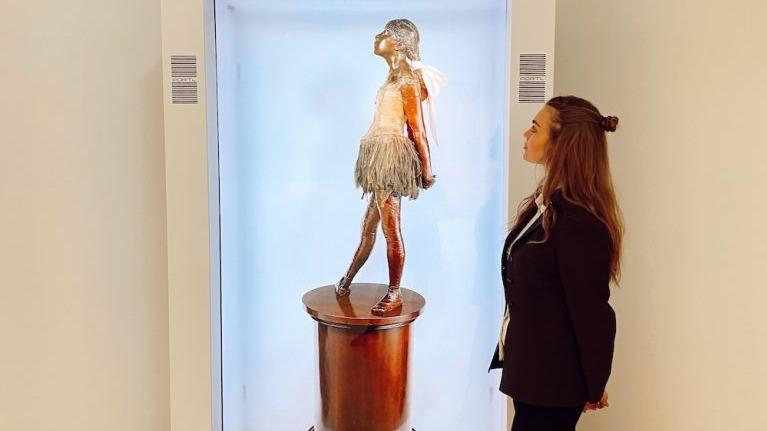Will the test be conclusive?
Holograms of Edgar Degas
' Little Dancer Aged Fourteen
have been on display since last week at Christie's in San Francisco and Hong Kong.
While the original will be on display at Rockefeller Center, New York, until it goes on sale May 12.
Instead of making the work travel, as usual, to present it to potential buyers, the auction house has opted for this device which ensures, according to it,
"an immersive and interactive experience"
.
Estimated between 20 and 30 million dollars, the bronze dressed in muslin, satin and a braid of real hair, constitutes one of the key works of the sale of the collections of the philanthropist Anne Bass, which also includes three Monets and two Rothkos.
All twelve lots could exceed 350 million dollars, according to estimates by Christie's.
To discover
YOUR COMMUNE - The results of the second round of the presidential election in your area
Discover the “Best of the Goncourt Prize” collection
Read alsoChristie's wins the final sale of Hubert de Givenchy's collections
“With this perfect holographic projection of a timeless icon of Impressionism, we push the boundaries of expected exhibition practices in fine art, fusing the traditional with the avant-garde like never before
.” is congratulated Ellanor Notides, president of Christie's West Coast in San Francisco.
"The hologram provides a realistic digital replica displayed in three dimensions rather than flat digital screens like televisions or our computer screens, which allows for an immersive and interactive experience
," said Devang Thakkar, senior adviser. for digital and technology at Christie's.
Read alsoIn the race for Hermès bags, Christie's takes the lead
In order to obtain this result, the auction house has taken care of the details.
Arranged in a large screen the size of a refrigerator, the hologram of the dancer rotates on itself, which makes it possible to see the work from any angle of view.
Spectators and potential buyers can freeze the hologram whenever they want and zoom in at will to contemplate every detail.
Read alsoThe National Gallery in London renames
Degas'
Russian
Dancers as Ukrainian Dancers
The auction house has teamed up with the specialized company Proto, based in Los Angeles and created only three years ago, which imagines that this type of device will become widespread.
"Increasingly, devices are being used for interactive experiences over long distances
," a spokesperson for Proto told The Art Newspaper.
Read alsoEdgar Degas, formidable painter of the movement, died on September 27, 1917
For the art world and particularly that of sales, the solution has many advantages.
The savings made on the cost of transport and insurance seem significant.
The security of the work and its integrity can also be better ensured.
More anecdotally, Christie's also highlights the reduction of the carbon footprint possible thanks to the device.
Not to mention that the work can be presented simultaneously anywhere in the world and probably in more places than if it had had to be toured in the major auction capitals.
Christie's does not talk about it but one can easily imagine that the device will make it possible to reach wealthy buyers in private places or to multiply the event evenings around prestigious lots.
It remains to be seen whether
Read also40 years later, ABBA releases a new album before a series of hologram concerts
One of the only recognized sculptures during Edgar Degas' lifetime
For this first attempt, Christie's chose this small statue, already well known in the markets.
“Degas has long held the world of ballet at the center of his artistic practice.
But unlike other artists, he often preferred occurrences behind the curtains, rather than on the front of the stage”
, explains Adrien Meyer, co-president of impressionist and modern art at Christie's.
Produced between 1875 and 1880, the work depicts a young dancer caught off guard, in a classical posture at rest, arms outstretched and crossed behind her back.
It was made almost life-size (101 centimeters) and inspired by Marie Van Goethem, a ballet student at the Paris Opera.
From the wax original, the statue was cast in bronze in 1918, a year after Edgar Degas died.
It is installed, from the top of its 101 centimeters, on a wooden base.
Christie's Images Ltd.
2022
Read alsoAt the Musée d'Orsay, a pas de deux with Degas
This wax representation is one of the only ones, among some 150 sculptures made by Edgar Degas, to have been recognized during his lifetime.
It was indeed presented in 1881, during the sixth Impressionist exhibition in Paris.
And one of the most innovative features of the work, which gives it its authenticity, is its dressing with real-life accessories: a dancer's cotton-faille bodice, linen ballet slippers, a tarlatan tutu , as well as a wig of real hair, collected in a braid and tied with a silk ribbon.
The original wax version of the
Little fourteen-year-old dancer
remained in the artist's studio until his death in September 1917. The bronze cast, which we know today, was only made posthumously in 1918, when the heirs of Edgar Degas called on the founder and artist Adrien Hébrard to make it.
Read alsoEdgar Degas, a music-loving and dancing painter

